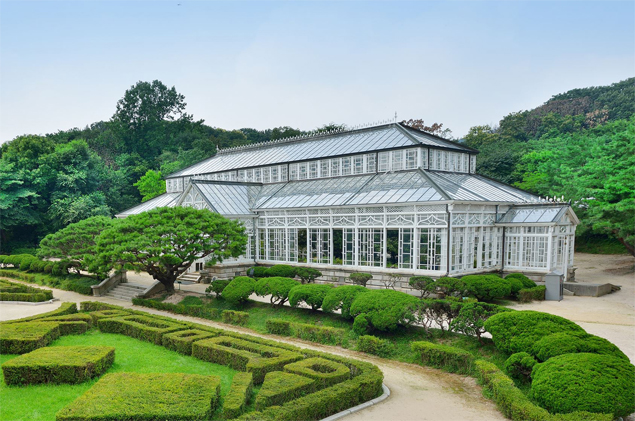Changgyeong Palace (Ch’anggyŏnggung)1 first opened its doors to general public in November 1909. What was once the royal grounds of the emperor Sunjong had undergone a renovation by Hirobumi Ito the first Japanese Resident-General in Korea – replacing and altering existing traditional architectures and landscape to build a new botanical garden, a zoo and a museum2. It was also renamed to Changgyeongwon (Ch’anggyŏngwŏn)3, which reflects its new identity as a park complex and its dignity as a former palace erased. This was only a foreshadow to the fall of Joseon Dynasty4 and Japanese Colonial Occupation in Korea5 the following year. In efforts to optimize control over its colonial capital Gyeongseong (Gyŏngsŏng –today’s Seoul), imperial Japanese government reformed the city by erecting colonial architectures and infrastructures either by demolishing or relocating Korean architecture that were symbolic of national heritage or power. Along with Changgyeonggung Palace, numerous traditional architectures were “deliberately targeted” to be destroyed – scarring the national pride and identity of Korea6. This colonial transformation of the city was veiled as modernization of Korea – to “educate … (and) to constitute Koreans as civilized subjects with a civil morality”6. In the post colonial period, Korea sought to decolonize the country by taking down several Japanese colonial architecture and reinstating some of the national architectural heritage. One of those efforts took place in Changgyeongwon as well, which involved the demolition and relocation of the Changgyeongwon Zoo out of the palace, re-landscaping Changgyeong Palace with local tress and plants and restoring its name as Changgyeonggung7. However, Changgyeonggung Palace Grand Conservatory (Ch’anggyŏnggung Daeonsil) which was a part of the botanical garden still remains in situ as a cultural heritage of Korea’s tragic history.
1 ‘gung’ means palace in Chinese character
2 Song and Woo, Investigation Report of the Greenhouse Documentation at Changgyeonggung, 33
3 ‘won’ means “an area in which to raise animals and tress surrounded by a fence” in Chinese (Lee, ‘Difficult Heritage’ in Nation Building: South Korea and Post-Conflict Japanese Colonial Occupation Architecture, 266)
4 Joseon Dynasty lasted over the period of 1384-1897
5 Japanese Colonial Occupation in Korea took place from 1910-1945. However, Korea lost its autonomous rights as a country upon signing the Protectorate Treaty with Japan in 1905. (Lee, ‘Difficult Heritage’ in Nation Building: South Korea and Post-Conflict Japanese Colonial Occupation Architecture, 66)
6 Lee, ‘Difficult Heritage’ in Nation Building: South Korea and Post-Conflict Japanese Colonial Occupation Architecture, 66
7 Lee, 266
Meiji Japan and French Influence
The Grand Conservatory is the first modern architecture ever built on the grounds of Korean royal palace by Japanese authorities. It is also the first Western-style conservatory built in Korea – using the glass and steel frame construction that resembles the Crystal Palace of London8. Its design and construction reflect how European imperialist ideologies and modernity influenced Japan in its national reformation of the late 19th century that took place after the Meiji Restoration in 1868. During this extensive process of modernization in Japan, several public parks were rapidly established as well as other imperial institutions that were typical in Western countries such as museum, zoo, and botanical garden in areas that are already accustomed as public sites across the country. In Tokyo, the parks were built adopting the ones in France, such as Parc Monceau and Bois de Boulogne9. Shinjuku Imperial Garden (currently known as Shinjuku Gyoen National Gardens) was designed by a French landscape designer Henri Martinet and was constructed based on Martinet’s drawings by a Japanese horticulturist Hayato Fukuba – who studied abroad in France9. Shinjuku Garden’s glass and steel framed conservatory (see fig.1) built in 1896 – the first of its kind in Japan but destroyed during the World War II – is considered as a precedent to Changgeyonggung Palace Grand Conservatory, also designed by Fukuba with the help of Martinet and constructed in 1909 by unknown French company10. On top of its formal and programatic resemblance to Shinjuku Garden, the siting of the aforementioned imperial Japanese institutions within Changgyeonggung palace added another layer of colonial context. In comparison to the Meiji era parks in Japan that were built on the existing public place, Changgyeongwon was built on the secluded royal grounds –desecrating it by making it a place of public entertainment and leisure.

8 Song and Woo, Investigation Report of the Greenhouse Documentation at Changgyeonggung, 54
9 Kim, “The Image of Changgyeongwon and Culture of Pleasure Grounds during the Japanese Colonial Period,” 5
10 Song and Woo, 36, 38, 54
The Empire Garden in the Colonial Capital
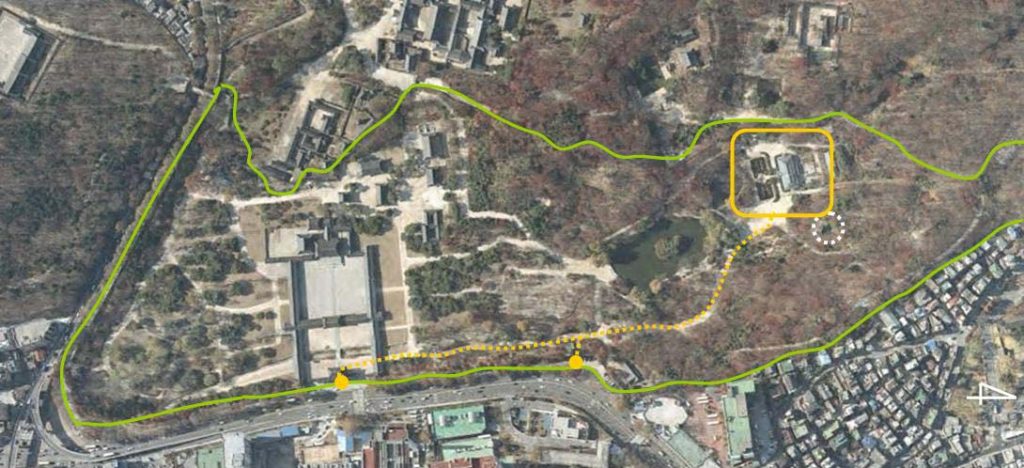
The Grand Conservatory sits in the northeast from the main entrance of the palace, a bit isolated from the rest of the buildings and with Chundangji the artificial pond to the south of conservatory (see fig.2 ). Right in front of the conservatory, there is a French-style garden with an ornamental fountain at the centre – which shows direct French influence in its construction(see fig.3). The amalgamation of colonial influences embedded in European Imperial architectural trends of the 19th century is also quite visible in the building details, such as the lattices with the mosque motifs and the metal ornaments shaped like pear blossoms sitting on the ridges of the roof (see fig.4,5).
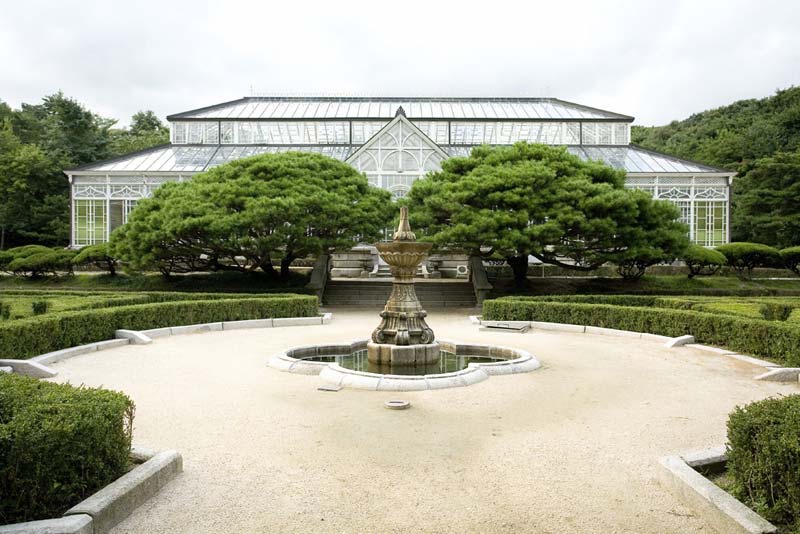
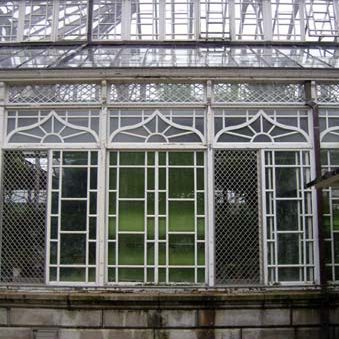
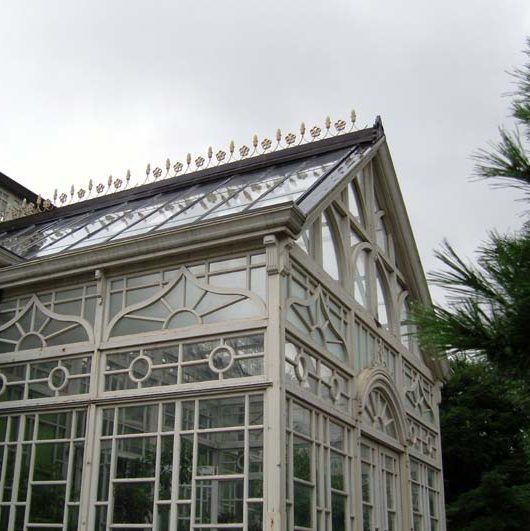
However, it is notable that its material construction is not entirely of steel and glass but a mixed use of wood and steel framing11. In his autobiography, Fukuba wrote that the design and plan of the conservatory construction was based on the set budget and scale of the Changgyeongwon project suggested by Hirobumi Ito12. Considering comparatively higher material cost of the steel at the time, it can be assumed that the mixed use of the wood and steel framings was necessary as a means to mediate the cost of construction. As a result, steel was used only as structural members with long spans or wherever critically needed and the rest of framing such as girders, rafters and window frames were built by wooden members 13. This also informs that the project was conceived prior to its contextual siting13 and the Japanese authorities were indifferent towards preserving the site’s geological conditions or context in constructing Changgyeongwon. It is vividly portrayed in contrast of these two plans from (see fig.6,7) that a true manifestation of empire garden held the most importance to the imperial Japan. It further exposes that the reasoning they employed in building such park ‘to modernize the Koreans’ was only superficial. In fact, Japan’s true ambition was to assimilate Koreans in to the imperial Japanese culture by erasing their traditions and places of cultural and spiritual heritage and “to cultivate new loyalties to the Japanese empire”14.
11 Song and Woo, 55
12 Song and Woo, 37
13 Song and Woo, 68
14 Lee, 63
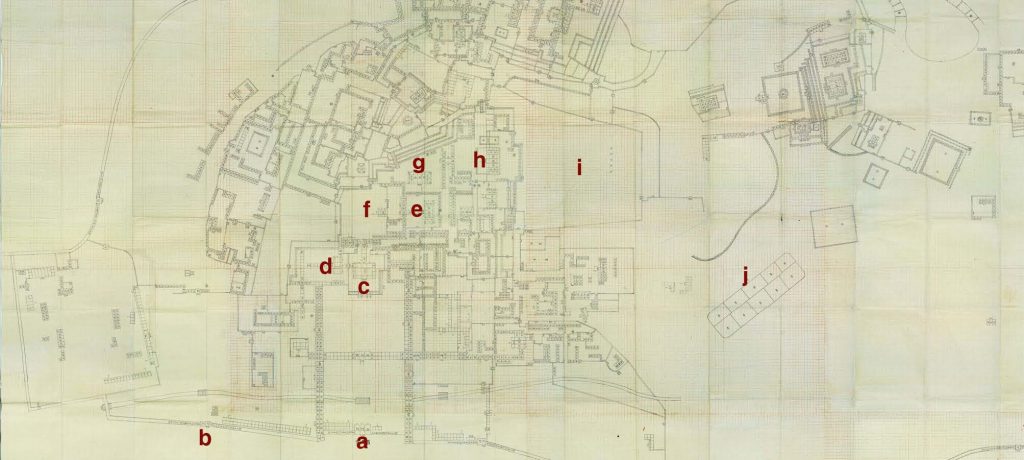
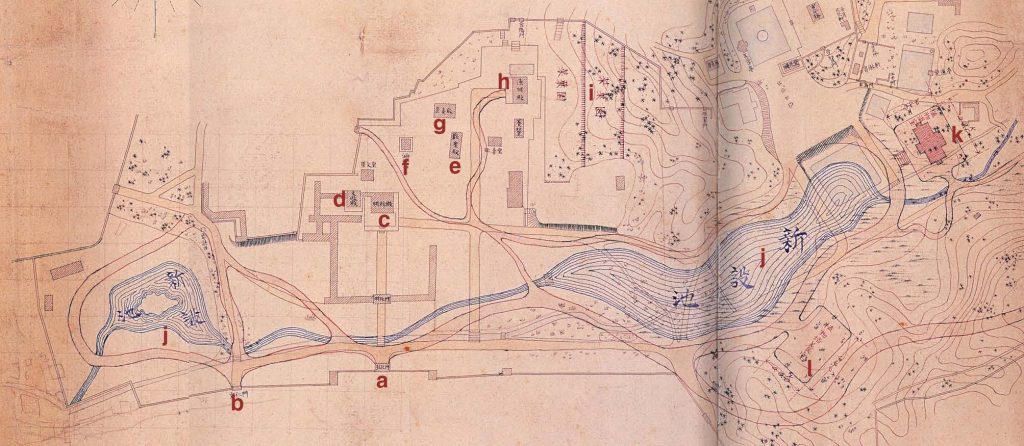
Constructing Imperial Spectacle
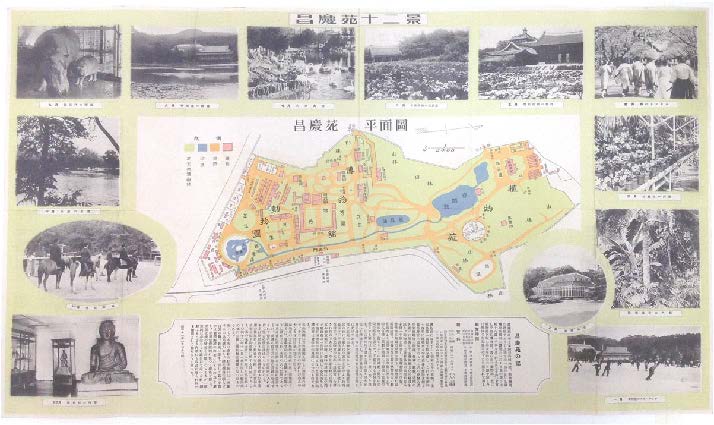
During its colonial occupation of Korea, Japan continued to develop Changgyeongwon as more elaborate amusement park with additional programs and seasonal events (see fig.8). The newspapers served to promote this new public place of leisure; it constantly featured the images of the exotic plants and flowers alike on display at Grand Conservatory encouraging more people to visit15. Eventually, the nursery in Changgyyeongwon started to sell flowers and bonsai plants – fostering the horticulture trend of growing indoor plants as a leisure in the city16. In 1924, Changgyeongwon reached its peak as a grand spectacle of imperial Japan when it opened to the public at night during the cherry blossoms season. The cherry blossom trees were extensively planted to heighten this experience.The lights that adorned the conservatory and gardens were reflected on the adjacent large pond Chundangji – creating an illusion of western steel and glass architecture shimmering afloat on the waters16. The nightly stroll called for more sensational and sensual spectacles and entertainment to be filled in Changgyeongwon, which further concealed Korea’s flickering heritage17. This colonial development was successful in establishing Changgyeongwon as a center of entertainment, “trigger(ing) a distorted connotation of the original palaces and Korean culture as “pre-modern,” meaning inferior and thus in need of change or replacement”18. Even after the liberation of Korea, Changgyeongwon continued to maintain its new name and operated as a public amusement park with ferris wheel and cable cars added until it went through a decolonization process in 198419. As a result, there exist “conflicting identities” of Changgyeonggung Palace across the different generations in Korea – constructed by each individual’s subjective experience and understanding of the site20.
15 Kim, 10
16 Kim, 11
17 Kim, 12
18 Kwon, “The Social Construction of Koreans’ Intergenerational Place Attachment to the Royal Palaces in Seoul,”194
19 Lee, 266
20 Kwon, 197
Exclusive ‘Public’ Good
To further dissect the layers of colonialism ladened on the Grand Conservatory and Changgeyongwon, it is essential to examine who were the subject of ‘public’ that were invited to enjoy this new place of leisure. First of all, people had to pay an admission fee except for Japanese students, foreigners and children under the age of five21. Secondly, there were strict rules in effect such as only allowing smoking and eating only in certain areas and banned those who are ‘lunatic’, ‘drunk’ or ‘poorly dressed’ from entering the park22. Drawing assumptions from how this former Korean palace was institutionalized as such in favour of the Japanese Empire, it was not much a welcoming place to be but uncomfortable and intimidating place for the most Koreans as colonized subjects. Furthermore, to pay an admission fee to enter the park for a weekend or to cultivate a hobby of growing indoor plants was a timely and costly luxury for the working class Koreans during this colonial period.The news articles that reported on the visitors of Changgyeongwon show that it mostly consisted of Japanese people or Korean Japanese government officials22. This again proves that the newly built park was mainly for the comfort and entertainment of Japanese public, celebrating imperial Japan’s achievements and its colonial trophies. For those Koreans who could afford to enjoy the park, it served as a place of active cultural assimilation – becoming insensitive and accustomed to their colonial reality.
21 Seo, “The Establishment and Character of the Zoo Purpose-built by Japanese Empire during the Korean Empire Period,” 29
22 Seo, 35
Conclusion
Changgyeonggung Palace’s Grand Conservatory still remains as a heritage site to remind Koreans of their tragic history. In addition, its formal qualities and larger programming of Changgyeongwon show how Meiji Japan sought to be ‘modern’ by adopting Western culture and ideologies. This trajectory of European Imperialism is very vivid in the heterogeneous design as seen in ornamental details of the conservatory. In order to ‘modernize’ Korea, the colonial government demolished numerous traditional Korean architecture not only in Changyeonggung Palace but also in other palaces nearby. It is estimated that more than ninety percent of Gyeongbokgung Palace, which was the main palace of Joseon Dynasty was destroyed to host an exhibition during the Japanese Colonial Occupation Period23. This indiscreet colonial development drastically changed the cityscape of Seoul – pulverizing the interconnection of various traditional palaces and other architectures cultivated in constructing the capital of Joseon Dynasty over the five centuries. Furthermore, Korea was already underway to its own modernization once it started to participate in international trade in the late 19th century24. Japanese Colonial Occupation “deprived the Korean of the chance to develop its own form of modernization … (by) repress(ing) nascent Korean modernity in favour of economic exploitation and cultural assimilation”25. This leaves one with an imagination of what Seoul’s cityscape would have looked like if Korea continued its autonomous modernization.
23 Kwon, 196
Lee, 63
24 Lee, 55
25 Lee, 4
Bibliography
Kim, Jeoung-Eun. “The Image of Changgyeongwon and Culture of Pleasure Grounds during the Japanese Colonial Period.” Journal of the Korean Institute of Landscape Architecture 43, no. 6 (December 31, 2015): 1–15.
Kwon, Jain. “The Social Construction of Koreans’ Intergenerational Place Attachment to the Royal Palaces in Seoul.” In , edited by Kopec, Dak and AnnaMarie Bliss. 1st ed., 194-207: Routledge, 2020.
Lee, Hyun Kyung. ‘Difficult Heritage’ in Nation Building. South Korea and Post-Conflict Japanese Colonial Occupation Architecture. Cham: Palgrave Macmillan, 2019.
Seeley, Joseph and Aaron Skabelund. ““Bite, Bite Against the Iron Cage”: The Ambivalent Dreamscape of Zoos in Colonial Seoul and Taipei.” The Journal of Asian Studies 79, no. 2 (2020): 429-454.
Seo, Tae-jung. “The Establishment and Character of the Zoo Purpose-built by Japanese Empire during the Korean Empire Period” Journal of Korean Modern and Contemporary History, no. 68 (2014): 7-42.
Song, In Ho and Woo, Dong Sun. Investigation Report of the Greenhouse Documentation at Changgyeonggung, Cultural Heritage Administration, 2007.
Images
- Title Image: “Grand Greenhouse”<http://english.cha.go.kr/html/HtmlPage.do?pg=/royal/RoyalPalaces_3.jsp&mn=EN_02_03_04>
- Fig. 1: A photo of Western-Style Conservatory in Shinjuku Garden featured in Fukuba’s autobiography
- Song, Minsoo. Investigation Report of the Greenhouse Documentation at Changgyeonggung, Cultural Heritage Administration, 2007: 54
- Fig. 2: Satellite image of Changgeyonggung and the Grand Conservatory
- Song, Minsoo. Investigation Report of the Greenhouse Documentation at Changgyeonggung, Cultural Heritage Administration, 2007: 47
- Fig. 3: Front Elevation of the Grand Conservatory
- Song, Minsoo. Investigation Report of the Greenhouse Documentation at Changgyeonggung, Cultural Heritage Administration, 2007: 7
- Fig.4: Mosque motifs on the window lattices
- Song, Minsoo. Investigation Report of the Greenhouse Documentation at Changgyeonggung, Cultural Heritage Administration, 2007: 58
- Fig. 5: Ornaments sitting on top of the roof ridges
- Song, Minsoo. Investigation Report of the Greenhouse Documentation at Changgyeonggung, Cultural Heritage Administration, 2007: 58
- Fig. 6: Donggwoldohyeong from late Joseon Dynasty; a plan drawing of Changgyeongung Palace
- Kim, Jeoung-Eun. “The Image of Changgyeongwon and Culture of Pleasure Grounds during the Japanese Colonial Period.” Journal of the Korean Institute of Landscape Architecture 43, no. 6 (December 31, 2015):7
- Fig. 7: A plan drawing from 1908 that shows Japanese government’s vision for Changgyeonwon project
- Kim, Jeoung-Eun. “The Image of Changgyeongwon and Culture of Pleasure Grounds during the Japanese Colonial Period.” Journal of the Korean Institute of Landscape Architecture 43, no. 6 (December 31, 2015):7
- Fig. 8: “Twelve Scenes of Shokeien(Changgyeongwon)”; a map of Changgyeonwon with featured photographs of seasonal experiences in the park.
- Seeley, Joseph and Aaron Skabelund. ““Bite, Bite Against the Iron Cage”: The Ambivalent Dreamscape of Zoos in Colonial Seoul and Taipei.” The Journal of Asian Studies 79, no. 2 (2020): 431.
